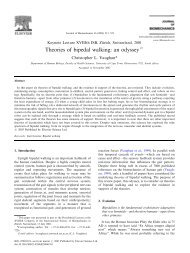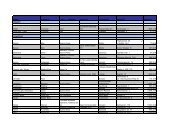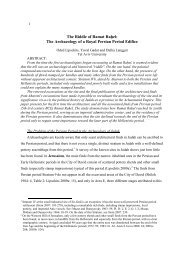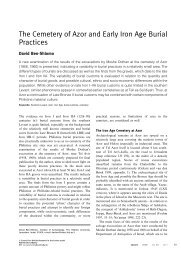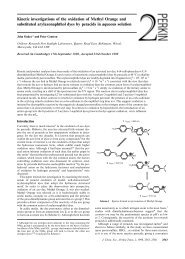Absorption and Transport of Cobalamin (Vitamin B12)
Absorption and Transport of Cobalamin (Vitamin B12)
Absorption and Transport of Cobalamin (Vitamin B12)
You also want an ePaper? Increase the reach of your titles
YUMPU automatically turns print PDFs into web optimized ePapers that Google loves.
Annual Reviewswww.annualreviews.org/aronlineCOBALAMIN ABSORPTION & TRANSPORT 349lamin <strong>and</strong> complexing <strong>of</strong> the released cobalamin with R protein, a glycoproteinsecreted by stomach <strong>and</strong> salivary gl<strong>and</strong>s. (b) In the intestinalluminal phase, cobalamin is transferred from R protein to intrinsic factor.This transfer is mediated by pancreatic proteases. (c) In the mucosal phase,the intrinsic factor-eobalamin complex attaches to ileal mucosal receptors,a necessary step before the cobalamin can be absorbed..4. Gastric PhaseAnnu. Rev. Nutr. 1982.2:343-369. Downloaded from arjournals.annualreviews.orgby Hebrew University <strong>of</strong> Jerusalem on 11/18/08. For personal use only.1. GASTRIC RELEASE OF DIETARY COBALAMIN Cooper & Castle (34)demonstrated that the low pH <strong>of</strong> the stomach <strong>and</strong> peptic digestion releasemost <strong>of</strong> the protein-bound cobalamin in food. The acid peptic digestion <strong>of</strong>food protein-bound cobalamin appears to be a necessary step for the release<strong>of</strong> cobalamin in some circumstances, since patients with hypo or achlorhydria,or partially gastrectomized patients, fail to absorb egg [SVCo]-cyanocobalamin (44). However, most patients with cobalamin deficiencyafter gastric surgery also have insufficient intrinsic factor (135). The absence<strong>of</strong> gastric proteolysis alone probably rarely causes deficiency, because thecobalamin bound to proteins in food can also be released by the pancreaticproteases.2. COBALAMIN BINDING TO R PROTEIN AND INTRINSIC FACTOR (IF)R proteins are a family <strong>of</strong> cobalamin binding proteins that move morerapidly than intrinsic factor on electrophoresis (63, 65). These R proteinsare present in gastric juice (64) <strong>and</strong> in saliva (15), from which theybeen purified (6, 19) <strong>and</strong> shown to bind cobalamin at both acidic <strong>and</strong> neutralpH (7). Allen et al (7) further showed that human salivary R protein-boundcobalamin with an affinity that was 50- <strong>and</strong> 3-fold higher than those <strong>of</strong>human intrinsic factor (IF) at pH 2 <strong>and</strong> pH 8.0, respectively. Even eobalaminbound to IF was transferred to an equal amount <strong>of</strong> R protein withTv2’s <strong>of</strong> 2 <strong>and</strong> 90 minutes at pH 2 <strong>and</strong> pH 8.0, respectively, whereas thereverse reaction did not occur. Digestion <strong>of</strong> R protein <strong>and</strong> R proteincobalamincomplex with pancreatic proteases led to a 150-fold decrease inthe affinity <strong>of</strong> R protein for eobalamin <strong>and</strong> a complete transfer <strong>of</strong> eobalaminto intrinsic factor in 10 minutes. These observations are <strong>of</strong> considerablephysiological importance <strong>and</strong> are discussed in Section III B.In the absence <strong>of</strong> 17, proteins, binding <strong>of</strong> cobalamin (cbl) to IF is rapid(78) <strong>and</strong> occurs over a range <strong>of</strong> pH values from 3 to 9 (7, 131). The bindingis stable; the complex can be broken only with 5 M guanidine hydrochloride<strong>and</strong> alkaline buffers (66). Binding <strong>of</strong> cbl induces conformational changesresulting in the formation <strong>of</strong> IF dimers <strong>and</strong> oligomers (5, 6). Affinitybinding for cbl is independent <strong>of</strong> the nature <strong>of</strong> the axial lig<strong>and</strong> X (Figure



